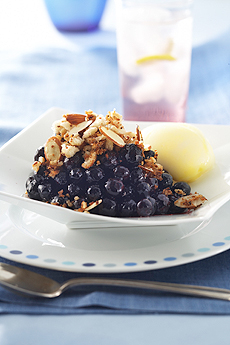 
A Blueberry Betty with almond topping. Photo courtesy of the US Highbush Blueberry Council.
June 2009
Last Updated August 2025
|
 |
Different Pastry Types: Pie & Pastry Glossary
Baklava & Other Types Of Pastry
Page 2: Definitions With B
CAPSULE SUMMARY: This is Page 2 of a ten-page glossary, including baklava, black bottom pie, and borek. Click the black links below to visit other pages. Also see our many other food glossaries, each featuring a different favorite food.
BAKEWELL TART
The Bakewell tart is a traditional British dessert that originated in the town of Bakewell in Derbyshire, England. It consists of a shortcrust pastry shell filled with layers of jam and frangipane (an almond-flavored custard), topped with flaked almonds. It evolved from the earlier Bakewell pudding. Here’s a recipe.
A Bakewell tart isn’t overly sweet, making it perfect for afternoon tea or even breakfast.
BAKING SHEET LINER
See pastry mat. |
|

Bakewell tart (photo © Bunsen Burner Bakery).
|
|
BAKLAVA
A Middle Eastern dessert made of layers of phyllo pastry filled with a mixture of ground nuts and sugar. The pastry is sliced, baked, and brushed with a honey syrup flavored with lemon or rosewater; the honey makes the pastry very sweet. The earliest form of the pastry was made in the 8th century B.C.E. in northern Mesopotamia, when the Assyrians layered very thin pieces of dough with nuts and honey, and baked them in wood-burning ovens. Greek seamen brought the concept home.
|
|
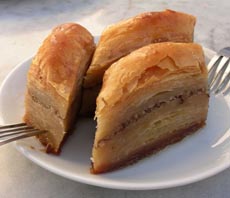
Baklava. Photo courtesy Wikimedia Commons. |
Athenian artisan bakers created phyllo, the leaf-thin layers of dough, and as early as the 3rd century B.C., the modern prototype of baklava was served in wealthy Greek households for special occasions. Other nations adapted the recipe: Armenians added cinnamon and cloves, Arabs added rosewater and cardamom. The pastry spread to the households of wealthy Persians and Romans; in the 4th Century C.E., when the Roman Empire expanded to Byzantium (modern Turkey), so did baklava. A Mediterranean favorite, it is easy to see why every country would want to claim baklava as its own!
Historical information courtesy of SinbadSweets.com.
|
BANANA CREAM PIE
While savory pies date back to ancient times, sweet pies—fruit, cream, custard, and pudding pies—date to Medieval times (the Middle Ages), which lasted from the 5th through the 16th century. In the High Middle Ages, from the 11th through 13th centuries, crusaders brought phyllo dough and baklava recipes back to Europe. But bananas did not arrive on a reliable basis until the 1880s, when improved transportation and aggressive promotion introduced what was to become a popular fruit. Banana cream pie, banana tarts, banana cake, and banana pudding soon followed.
BANBURY TART
A smaller, individual-sized portion of Banbury cake, often a smaller, individual-sized version. It’s actually not a tart but a turnover, a raisin and cracker crumb filling, accented with lemon zest, and enclosed on all sides by crimped pastry. Here’s more about it.
|
|
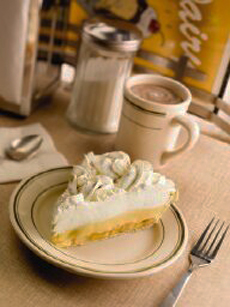
Banana Cream Pie. Photo courtesy Wisconsin Milk Marketing Board.

Banbury tart, actually a turnover (photo © Lavender and Lovage). |
BANOFFEE PIE
A U.K. specialty, this rich dessert is a BANana-tOFFEE pie with whipped cream and a cookie crust, topped with grated chocolate. Purportedly invented in the 1970s by a restaurant in East Sussex, England, it’s easy to bake. Aside from the sweet-and-salty graham cracker crust, there’s no baking involved. Here’s a recipe.
The flavor combo became so beloved that it inspired many other banoffee desserts, such as banoffee cheesecake, trifles, and cakes. |
|

There’s a banana-toffee filling under that whipped cream and grated chocolate (photo © Taste Of Home).
|
|
BAVARIAN CREAM PIE
Before there was Bavarian Cream Pie, there was crème bavarois—Bavarian Cream, an early 19th-century dessert credited to the great chef, Marie-Antoine Carême. While the connection to Bavaria is obscure, Carême created great dinners for royalty and others at the top of society, so the dessert may well have been created to honor guests from Bavaria. Bavarian Cream (without the pie) is a mold of crème anglaise (a pourable custard sauce) combined with gelatin, beaten egg whites, and lightly whipped cream. It can be flavored with vanilla, fruit purée, chocolate, liqueur, etc. It was originally poured into a decorative mold, chilled, and unmolded. Here’s a photo of a simple molded Bavarian cream—no elaborate mold. As with custard and a number of other foods originally served in a dish, at a point lost in history, some chef poured the cream into a pie crust to create Bavarian Cream Pie.
|
|
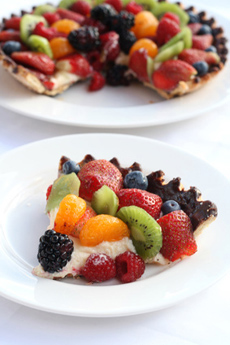
Banana Cream Pie. Photo by J. Java | Fotolia. |
The pie can be served plain or topped with shaved chocolate, chocolate sauce, or fruit (as in the photo above). BUT NOTE: Real Bavarian cream does not pipe smoothly because of its gelatin. In the U.S., products called “Bavarian cream” pie (and doughnuts) are actually filled with a version of a crème pâtissière (pastry cream)—so they’re “faux” Bavarian Cream Pie. November 27 is National Bavarian Cream Pie Day.
BEAR CLAW
A pastry made from yeast pastry or laminated dough, roughly shaped like a bear’s claw. The one in the photo, from JoePastry.com, is more attractive and claw-like than most! The dough can be almond-flavored or can have an almond paste filling. The filling can also include raisins or chopped dates. Often, the top is striped with fondant and sometimes, sliced almonds.
|
|
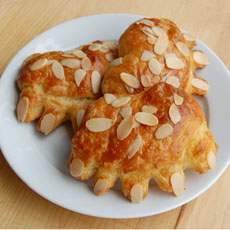
Yummy bear claws. Photo courtesy JoePastry.com. Get the recipe.
|
|
BEIGNET
A beignet (bayn-YAY, the French word for bump) is deep-fried choux pastry dough, similar to German Spritzkuchen, Italian zeppoles, and Spanish churros. It can take different shapes and flavorings depending on local preferences. In New Orleans, beignets are like doughnut holes, typically sprinkled with confectioners’ sugar. They’ve caught on at stylish restaurants nationwide, which serve them as dessert with a dipping sauce. In France, the term refers to a variety of fried-dough pastry shapes with fruit fillings. Beignets made with yeast pastry are called Berliners Pfannkuchen in Germany (the equivalent of an American jelly doughnut) and boules de Berlin in French. The beignets at Cafe du Monde in New Orleans are worth going out of your way for (they taste best at the main location). After buying their mix and making them at home, we were unable to match the glory of the original.
|
|
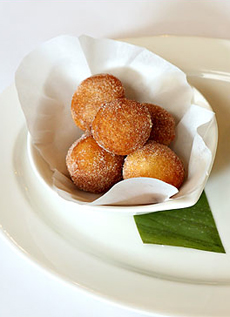
Beignets, served with a dipping sauce (not shown). Photo courtesy Orsay Restaurant | New York City. |
|
BETTY or BROWN BETTY
Most often found in recipes for a Brown Betty or an Apple Brown Betty, a betty is a crisp topped with buttered bread crumbs or bread pieces instead of streusel or another topping; later recipes also use graham cracker crumbs (see the history of the graham cracker, which postdates the Brown Betty). In some recipes, sugared and spiced fruit, usually diced apples (although any fruit can be used), is placed in alternating layers with the crumbs and baked, covered, to the consistency of bread pudding. The dish and name date back to colonial times, but the original “Betty” is lost to history; the brown refers to the brown sugar in the recipe. See also cobbler, crisp and grunt.
|
|

An Apple Fig Brown Betty. Photo courtesy Betty Crocker. Here’s the recipe. |
|
BIGNÉ
The Italian word for pâte à choux.
BISCOTTI
While it’s a cookie, not a pastry, we include this twice-baked Italian biscuit. Traditionally flavored with anise or nuts, biscotti are now made in a wide variety of flavors. See the history of biscotti.
|
|
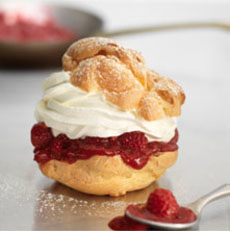
Cream puffs and éclairs are the most popular forms of pate a choux pastry. Photo courtesy Oregon Fruit Commission. |
|
BLACK BOTTOM PIE
A chiffon pie made with two flavors of custard. The bottom layer is chocolate custard, the top layer is rum-flavored vanilla custard, although banana pudding is also popular. The pie is topped with a thin layer of sweetened whipped cream and sprinkled with thin shavings of chocolate. In general, “black bottom” refers to a bottom layer of chocolate. You can make a black bottom cake, cupcake, etc. A black bottom pie can also have a chocolate cookie crust, or can use the chocolate crust instead of the chocolate custard bottom; for example, a cream pie with a chocolate crust. The famous black bottom pie from Weidmann’s in Meridian, Mississippi, has a crust of crushed gingersnaps topped with a layer of chocolate cream and then a bourbon-flavored vanilla layer, topped with whipped cream and chocolate shavings or syrup.
|
|
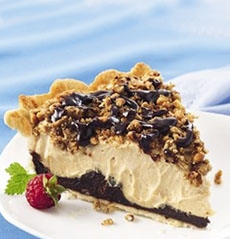
A slice of black bottom peanut butter pie, a Pillsbury Bake-Off winner. Here’s the recipe. Photo courtesy Pillsbury. |
BOCCONOTTI
See pasticiotti.
|
BOREK or BOUREK
Fried, filled pastries made of flaky phyllo dough (phyllo is called yufka in Turkish), borekas can be filled with feta or other cheese, minced meat, or vegetables. The pastry is popular throughout the countries of the former Ottoman Empire. It can be made in a whole round pie or in individual versions, such as those in the photo, which themselves can be triangular, cigar-shaped, rose-shaped, and other versions.
BOUCHÉE
Miniature tart shells or cream puffs (puff pastry shells) that can contain sweet or savory fillings.
|
|
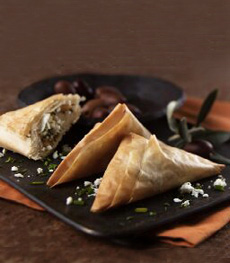
Individual borek appetizers. Photo courtesy Wisconsin Milk Marketing Board. |
|
BREAKFAST PASTRY or BREAKFAST
BREAD
A breakfast bread is a bread traditionally reserved for the morning meal. It can be sweet or savory; a savory bread, such as a croissant, is typically served with a sweet embellishment such as preserves. Other examples include almond croissants, pain au chocolate, and other Viennoiserie, Danish, diplomats, and financiers. The difference between a pastry and a “breakfast pastry” is that the latter contains far less sugar and fewer rich embellishments.
|
|
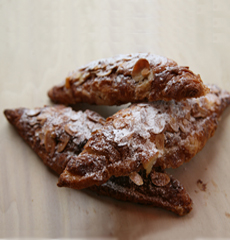
Almond croissants. Photo courtesy Tisserie.com. |
|
BREAKFAST PIE
Typically, a savory pie crust filled with breakfast items—eggs, cheese, and breakfast meats. Breakfast wraps, tacos, and the McMuffin are other examples of porting plated breakfast foods into a bread wrapper. Historically, pies were savory items, as bread was a Western invention and sugar is native to the Pacific Rim. The original pies were meat pies; the first fruit pies, sweetened with very expensive sugar, were treats for the very wealthy in the 17th century, when Portuguese traders brought sugar to Europe. It wasn’t until the latter part of the 18th century that sugar became affordable to the middle class, and cakes and pies became an affordable treat.
BUCKLE
Buckles are baked and are usually made in one or two ways: a cake-like bottom layer with berries (typically blueberries) mixed in and a crumb top; or in three layers with cake at the bottom, berries in the middle, and a crumble top. If the top of this cake “buckles,” i.e., caves inward, that’s what it’s supposed to do.
Buckle can be served as a breakfast item or as a dessert, with whipped cream or à la mode. While blueberry buckle is a popular recipe, any summer fruit is delicious in a buckle. The recipe in the photo has both peaches and blueberries.
The differences between crisp, crumble, cobbler, betty, buckle, and more.
Also see cobbler.
|
|
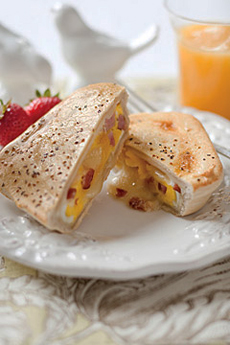
Breakfast pie. Photo courtesy MackenzieLtd.com.
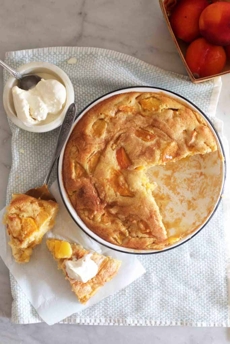
Peach-blueberry buckle. Here’s the recipe (photo © The Baker Chick).
|
|
BUTTERMILK PIE
A Southern specialty, buttermilk pie is one of the desperation pies, simply made with kitchen staple ingredients when there was no fruit available. It has a flaky pastry crust and creamy, custard-like filling. A pie crust is filled with a mixture of sugar, butter, flour, eggs, buttermilk, and flavorings such as lemon and vanilla. Here’s a recipe. Some recipes add coconut or nutmeg flavorings.
Buttermilk pie is similar to, and sometimes confused with, chess pie, but the latter has a cornmeal crust.
|
|
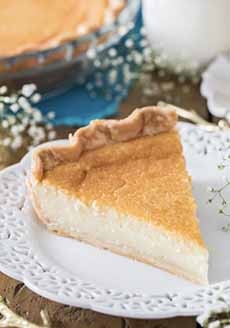
Buttermilk pie (photo © Sugar Spun Run).
|
Continue To The Next Page: Terms With C
Go To The Article Index Above

|




















